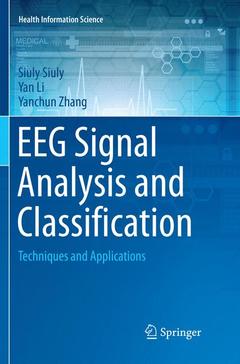Description
EEG Signal Analysis and Classification, 1st ed. 2016
Techniques and Applications
Health Information Science Series
Authors: Siuly Siuly, Li Yan, Zhang Yanchun
Language: English
Subjects for EEG Signal Analysis and Classification:
Keywords
Electroencephalogram (EEG); Epileptic seizure; Feature extraction; Classification; Brain computer interface (BCI); Motor imagery (MI); Clustering technique (CT); Simple random sampling (SRS); Cross-correlation (CC) technique; Optimum allocation technique; Least square supper vector machine (LS-SVM); Logistic regression (LR); Kernal logistic regression (KLR); Optimum allocation sampling; k-NN; Multinomial logistic regression with a ridge estimator; Support vector machine (SVM); Naive Bayes method
147,69 €
Disponible chez l'éditeur (délai d'approvisionnement : 15 jours).
Add to cartPublication date: 07-2018
Support: Print on demand
147,69 €
Disponible chez l'éditeur (délai d'approvisionnement : 15 jours).
Add to cartPublication date: 01-2017
Support: Print on demand
Résumé
/li>Sommaire
/li>Commentaire
/li>




